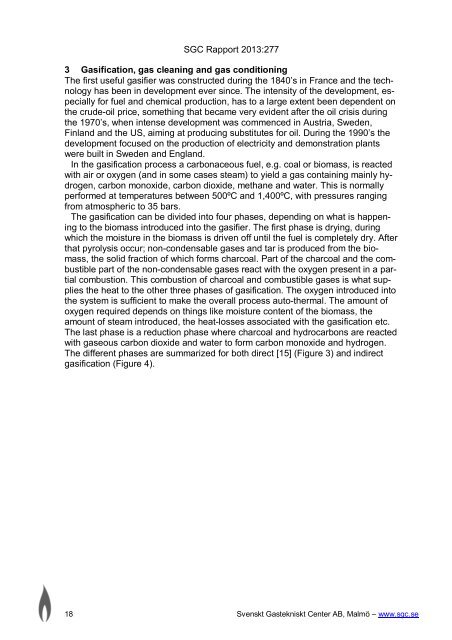Carbon dioxide removal in indirect gasification - SGC
Carbon dioxide removal in indirect gasification - SGC
Carbon dioxide removal in indirect gasification - SGC
Create successful ePaper yourself
Turn your PDF publications into a flip-book with our unique Google optimized e-Paper software.
<strong>SGC</strong> Rapport 2013:277<br />
3 Gasification, gas clean<strong>in</strong>g and gas condition<strong>in</strong>g<br />
The first useful gasifier was constructed dur<strong>in</strong>g the 1840’s <strong>in</strong> France and the technology<br />
has been <strong>in</strong> development ever s<strong>in</strong>ce. The <strong>in</strong>tensity of the development, especially<br />
for fuel and chemical production, has to a large extent been dependent on<br />
the crude-oil price, someth<strong>in</strong>g that became very evident after the oil crisis dur<strong>in</strong>g<br />
the 1970’s, when <strong>in</strong>tense development was commenced <strong>in</strong> Austria, Sweden,<br />
F<strong>in</strong>land and the US, aim<strong>in</strong>g at produc<strong>in</strong>g substitutes for oil. Dur<strong>in</strong>g the 1990’s the<br />
development focused on the production of electricity and demonstration plants<br />
were built <strong>in</strong> Sweden and England.<br />
In the <strong>gasification</strong> process a carbonaceous fuel, e.g. coal or biomass, is reacted<br />
with air or oxygen (and <strong>in</strong> some cases steam) to yield a gas conta<strong>in</strong><strong>in</strong>g ma<strong>in</strong>ly hydrogen,<br />
carbon monoxide, carbon <strong>dioxide</strong>, methane and water. This is normally<br />
performed at temperatures between 500ºC and 1,400ºC, with pressures rang<strong>in</strong>g<br />
from atmospheric to 35 bars.<br />
The <strong>gasification</strong> can be divided <strong>in</strong>to four phases, depend<strong>in</strong>g on what is happen<strong>in</strong>g<br />
to the biomass <strong>in</strong>troduced <strong>in</strong>to the gasifier. The first phase is dry<strong>in</strong>g, dur<strong>in</strong>g<br />
which the moisture <strong>in</strong> the biomass is driven off until the fuel is completely dry. After<br />
that pyrolysis occur; non-condensable gases and tar is produced from the biomass,<br />
the solid fraction of which forms charcoal. Part of the charcoal and the combustible<br />
part of the non-condensable gases react with the oxygen present <strong>in</strong> a partial<br />
combustion. This combustion of charcoal and combustible gases is what supplies<br />
the heat to the other three phases of <strong>gasification</strong>. The oxygen <strong>in</strong>troduced <strong>in</strong>to<br />
the system is sufficient to make the overall process auto-thermal. The amount of<br />
oxygen required depends on th<strong>in</strong>gs like moisture content of the biomass, the<br />
amount of steam <strong>in</strong>troduced, the heat-losses associated with the <strong>gasification</strong> etc.<br />
The last phase is a reduction phase where charcoal and hydrocarbons are reacted<br />
with gaseous carbon <strong>dioxide</strong> and water to form carbon monoxide and hydrogen.<br />
The different phases are summarized for both direct [15] (Figure 3) and <strong>in</strong>direct<br />
<strong>gasification</strong> (Figure 4).<br />
18 Svenskt Gastekniskt Center AB, Malmö – www.sgc.se

















